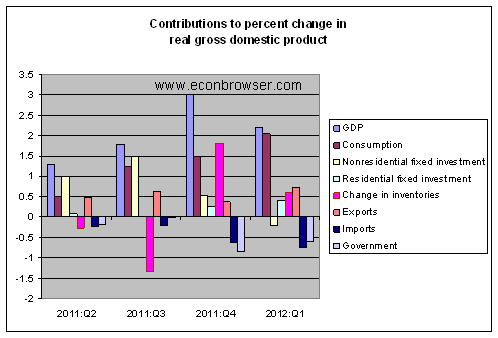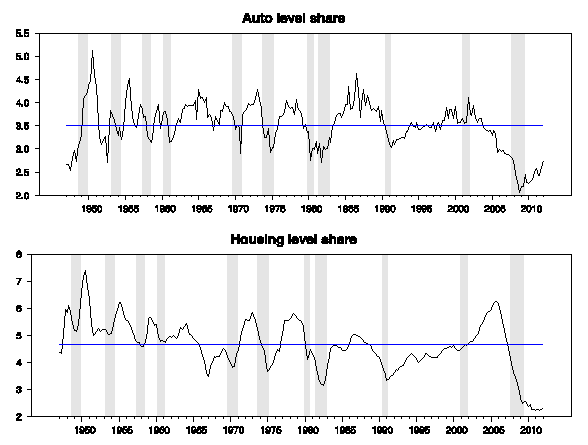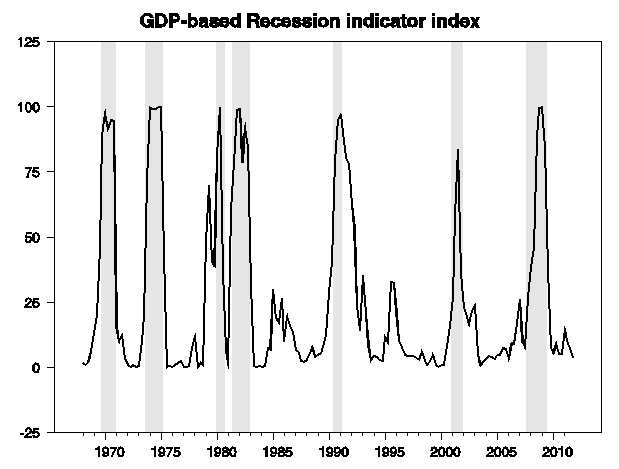The Bureau of Economic Analysis reported today that U.S. real GDP grew at a 2.2% annual rate during the first quarter, down from the 3.0% growth of 2011:Q4, and below the 2.4-2.9% range that the FOMC indicated yesterday it is anticipating for 2012 as a whole. I see some reasons to agree with the Fed that the rest of the year may be slightly better than the first quarter.
Lower spending by federal, state, and local governments subtracted 0.6% from the first quarter’s growth rate. Continuing federal fiscal drag seems likely for the rest of the year. An even bigger disappointment in the 2012:Q1 GDP report might be nonresidential fixed investment. This had been making a solid contribution over the previous year, but subtracted 0.2% from Q1 growth. If business investment continues to make a negative contribution for the rest of the year, it could pose a stiff headwind.

But I think it’s worth emphasizing what’s been happening in two sectors that play a critical role in most business cycles. Housing contributed 0.4 percentage points to the 2.2% Q1 growth, and autos an additional 0.7 percentage points. These two categories usually make a big contribution both to the drop in GDP during a recession as well as to the rebound usually seen in the early recovery phase. For example, in the 2007:Q4-2009:Q2 recession, real GDP fell on average at a 2.7% annual rate, with autos and housing accounting for about half of this decline all by themselves.
 |
One of the unusual features of the recent data is that these two key sectors contributed very little to the first two years of the recovery, with autos only adding 0.1 percentage point to the average annual GDP growth over 2009:Q3-2011:Q3 and housing actually exerting a very slight drag. However, the last 6 months have been closer to the typical pattern, with autos contributing 0.8% and housing 0.3%.
Moreover, further growth in these sectors from here does not require any pent-up demand. If sales simply get back to historical replacement rates and meeting population growth, it would be a huge improvement over where we are right now.
 |
The slow pace of GDP growth continues to disappoint, particularly for the 12.7 million Americans actively looking for jobs and still unable to find them. On the other hand, the U.S. is unquestionably better off than would be the case had the September prediction of the Economic Cycle Research Institute that the U.S. was about to enter another recession proved to be accurate. The latest GDP report brings our
Econbrowser Recession Indicator Index down to 4.0%. For purposes of calculating this number, we allow one quarter for data revision and trend recognition, so the latest value, although it uses today’s released GDP numbers, is actually an assessment of where the economy was as of the end of the last quarter of 2011. The index would have to rise above 67% before our algorithm would declare that the U.S. had entered a new recession.

|
Not a recession, though of course we are all hoping for something much better than what we have so far. For other takes, see Phil Izzo, Karl Smith, and the always indispensable Calculated Risk.
Is the drop in durable goods orders factored into your recession index? It is the economic news that scares me.
One has only to do a Google search for “consumer malaise” and limit it to the past month to get a picture of worldwide economic sentiment. Not a recession, perhaps, but not what one normally thinks of for recovery and growth.
Why is the GM explosion in inventory considered to be a sign that the automobile sector is out of recession? And what about housing? If Fannie and Freddie put a hold on their foreclosure activities during an election year house prices (and starts) may go up. But given the shadow inventory how can you have the basis for a sound recovery for the sector? While I am at it, shouldn’t the impact of the much warmer than usual temperatures have a very large positive effect that should be scrubbed from the data?
Sluggish U.S. growth continues
Hey, I resemble that remark!
The only thing worse than the 2.2% growth rate is that 93% of it will go to the top 1%.
Getting back to auto sales in line with historical averages and population growth will be very difficult. The price of new cars is getting to be outrageous, in part thanks to Obama’s CAFE standards.
In the near future, there simply will not be inexpensive small cars, because of the cost of technology to meet these CAFE standards. The corresponding savings in fuel will not offset the increased costs in the useful life of the vehicle.
Buzzcut The price of new cars is getting to be outrageous, in part thanks to Obama’s CAFE standards.
I don’t see any evidence for this claim. According to the BLS website, the Producer Price Index of passenger car prices in Feb 2002 stood at 131.1, with a 1982 base year. Ten years later, the provisional index for Mar 2012 is 131.1. No change.
Series ID: WPS141101
The general consensus among economists is that CAFE standards are a “second best” solution, with a refundable Pigou style carbon tax being the optimal choice. But given that we have myopic voters and crass politicians, second best is probably the best we can hope for. Such is life in a Tea Party country. In any event, the auto industry welcomed the Obama CAFE standards.
Slugs, much like your comment that Ford welcomed the bailout, you’re being very naive. Obama keeps tabs on Romney donors. I’d “support” the CAFE standards, too, if I were an automaker.
The average price of a new car is over $30k. The only reason that your index says that prices are not rising is because they offset the price increases for the increased content mandated by CAFE. But that doesn’t mean that people would freely choose this technology if they had a choice.
Doug Ross argues that the deflators used to calculate the growth rate were understated which results in an overstated growth rate:
http://directorblue.blogspot.com/2012/04/ruh-roh-first-quarter-gdp-wasnt-even.html
Buzzcut You’re confusing prices. My reference was to the PPI for automobiles, which refers to how much it costs to produce an automobile. At least until very recently the single largest component of a car’s production cost was healthcare, which is why the Big Three automakers supported a Canadian style single payer system, and it’s why they supported Obamacare. The power of unions has also declined, which helped hold down production costs. Finally, in the wake of the bailout agreement the Obama Administration was able to convince the unions to concede pension benefits in exchange for company equity and significant control. All those things helped make Detroit more competitive and helped hold down production costs. The $30K figure you mentioned is the average sale price, which includes dealer profit, commissions, shipping, local demand & scarcity for a particular vehicle type, etc. The higher sale prices also reflect consumer demand for added gadgets and whizbang features, and that’s where dealers make their money. Your comment about CAFE standards was about how imposing those standards raised the production cost of cars, and that’s why car prices have increased. This is just wrong. You might find this interesting:
http://content.usatoday.com/communities/driveon/post/2012/04/car-prices-hit-record/1
Aside from the environmental arguments for CAFE standards, there is also a good macroeconomic argument for them. As JDH and Menzie have pointed out, oil prices tend to follow a random walk, which means that they are essentially unpredictable and the variance of the forecast increases with time. It also means that all price shocks are permanent…this is just a consequence of there being a “unit root” in the autoregression. You know all about regressions and autocorrelation errors, right? Anyway, oil price shocks have contributed in no small way to many of our recessions over the last 40 years, so policies that dampen our vulnerability to price shocks also contribute to macroeconomic stability. It’s also quite likely that oil prices will be come more predictable as the reality of peak oil begins to dawn on people, but on the cusp of that realization we should expect price volatility to increase. You know all about autoregressive conditional heteroskedasticity, right? CAFE standards are not the ideal solution, but they are much better than just letting myopic consumers endlessly chase forecast error as they flit about from gas guzzlers to gas misers and then back again to gas guzzlers.
What value was the algorithm at for the beginning of the Great Recession, ~6% by visual inspection?
energyecon: The value for 2007:Q4 was 26.9%.
As long as we are throwing around links, I like this one. It gets into the nitty gritty of the technology that needs to be used to meet these CAFE standards, and what the costs actually are.
The biggest shock is that the ONLY car currently that can meet the new CAFE standards in their entirety is the Toyota Prius. We are taking a big chance that these standards can be met at all.
I just bought one of these “CAFE enhanced” cars. It has direct injection and a 6 speed automatic, probably costs $1000 more to make than a previous model with the same engine but port fuel injection and a 4 speed automatic. It probably gets a couple more mpg combined. Under no circumstances would a consumer make that tradeoff, the return on investment just doesn’t work.
In the past, automakers would use this kind of technology to improve horsepower, which consumers will actually pay for.
You can argue all you want that other factors explain the increase in car prices, but it is a fact that these “CAFE enhancements” cost more money than the technologies that they replace. It isn’t an insignificant cost. It is thousands of dollars per car. The automakers don’t give it away for free.
Also, what people fail to realize is that the way that these standards are written, small cars as well as large cars need to improve their mileage significantly. That means that small cars will get more expensive, to the point where people can’t simply downsize (like they did in the first round of CAFE in the ’70s).
The fact is that technocratic solutions like CAFE have more unintended consequences than the “experts” are willing to concede.
Buzzcut Now you’re trying to shift the argument. Originally you said that higher CAFE standards explained what you perceieved as increased production costs. In other words, you were making an argument about history. Now you’ve apparently abandoned that argument and you just shifted to an argument about how higher CAFE standards might affect future production costs.
First, technology based solutions tend to become much cheaper over time. The cost is in the upfront engineering and design, but the actual production costs tend to decline. Television sets, cell phones and computers are good examples. A large screen HD television costs less today than a small screen analog television did 10 years ago. Same with cell phones. Same with computers. And it’s the same with high-tech stuff in autos. Remember how expensive fuel injection was over old fashioned carburetors? Why do you think it will be any different with this generation of efficiency improvements?
It is true that consumers have tended to take the higher efficiency of today’s engines and use it to buy more horsepower rather than more fuel economy. That’s absolutely the case. But higher horsepower is a piece of vanity and machismo that we probably can’t affort anymore. Do you really need a 500hp vehicle to sit in a traffic jam? It might overcome your manly shortcomings, but I don’t think personal dramas should trump sound economic policy. The fact is that higher mileage vehicles will make us less vulnerable to price shocks even though they might make short run demand more inelastic. If fuel costs make up a smaller percentage of a family’s budget, then price shocks will have less effect overall. We won’t see this lurching between big and small cars that have characterized the auto market ever since the 1973 oil embargo.
JDH If I’m understanding the recession index correctly, it looks like all you need to know is if the index reaches 30. If the index reaches 30, then you can predict with a very high degree of confidence that the economy either is already in a recession or will soon be in a recession. The only exception is in 1979, but even here there was a quick reversal and a recession followed very soon after. So economists had no reason to claim in 2008:Q2 that there was minimal risk of an economic downturn on the horizon. In fact, they weren’t even entitled to make this claim in late 2008:Q1. The 2007:Q4 data shown on the chart would have been available in late 2008:Q1, and a reading of 26.9 is uncomfortably close to 30.
One point of confusion. Your graph just shows index numbers ranging from -25 to +125, but your reply to energyecon stated it as a percent. Should we think of it as a percent or just as a number with plausible values ranging from -25 to +125? Or are the -25 and +125 numbers an artifact of Excel or whatever?
Bruce Hall: Thanks for the link to directorblue. I will add it to my collection of blogs like John Williams’ Shadowstats. Wow.
2slugbaits: The index is always between 0 and 100 by construction. Setting the scale on the graph from -25 to +125 is just intended to make it easier to see when it bumps up near one of the boundaries.
Slugs, looking at new cars and the technology that they are incorporating, there is no question that part of the increased pricing is CAFE driven technology. More gears in the transmissions, alternative transmission designs like CVTs and dual clutch automated manuals, direct injection, and various levels of hybridization are all well evidenced in current models.
Moving forward, I predict that pretty much every car sold is going to need some level of hybridization in order to be sold in the US (extrapolating from the fact that the Prius is the only car that can meet Obama’s future CAFE standards). So, yes, the future is going to be even more expensive than the present!
Slug wrote:
The only thing worse than the 2.2% growth rate is that 93% of it will go to the top 1%.
Slug,
Very perceptive! And it will go as stimulus, or in Keynes speak investment, from tax revenue. Can you say crony capitalism? Better, can you say laundering campaign cash in an election year?
I see many reasons to disagree with the Fed’s outlook for the rest of 2012, the most notable being less than one percentage point growth of real disposable income for the last year-and-a-half. Exactly how is that massive 70%-of-the-economy shortfall going to be made up by the other components of GDP without releveraging by households? There is no locomotive this time as there was in 2001 (housing), 1990 (tech boom), and 1982 (humungous decline from record level interest rates).
Buzzcut — what you should do is go to table
7.2.5.u of the national accounts
where you will find data on the average price
of new cars and light trucks purchased in the US.
The average price of a new car sold In March, 2012
was $25,395. This is significantly below the some $30,00 you claimed. This was up some 3.36% from a year ago. Since 1990 the average annual increase in new car prices has been 2.7% and it has actually been slowing in recent years.
This data massively contradicts your claims that regulations by Obama is causing new car prices to soar.
Buzzcut:
Bicycles upped their tech to ten speeds in the 1960’s with 24 pretty common now and CAFE had nothing to do with it. Why have cars, and especially pickup trucks and vans, continued to lag so far behind bicycles?
Buzzcut So, yes, the future is going to be even more expensive than the present!
If you’re ambitious enough you can always go to the NHTSA report “Final Regulatory Impact Analysis, Corporate Average Fuel Economy for MY 2012-MY 2016 Passenger Cars and Light Trucks” but it’s over 600 pages long. But lots of charts, tables and graphs. Or if you’re lazy like me, you could just read an NBER paper that’s already waded through the numbers from the NHTSA report:
“Automobile Fuel Economy Standards: Impacts, Efficiency, and Alternaives,” NBER Working Paper #16370, Sep 2010. According to the authors:
“NHTSA (2010) estimated that its new standard would add about $900 in incremental technology costs for the average new vehicle in 2016 but generate about $3,200 in fuel savings and other private benefits (e.g., reduce refueling time), implying a negative net private cost of about $2,300 per vehicle.”
So CAFE standards would actually save consumers $2,300.
There are other things to consider. First, the CAFE rules would allow automakers to trade permits. And the penalty for not meeting the guidelines is only $55 per mile per gallon missed. In the case of the US, the maximum penalty would only amount to about $550 per vehicle. Of course, the new US CAFE standard is the lowest in the world, so if GM wants to sell Buicks in China, GM would have to exceed the US CAFE standards anyway if they wanted to stay in the Chinese market. As I said before, CAFE standards are a second or third best solution. If you want a better solution, then support a higher gas tax.
JBH Exactly how is that massive 70%-of-the-economy shortfall going to be made up by the other components of GDP without releveraging by households?
How about increasing government spending in order to soak up excess savings and provide those households with the secure and highly liquid assets that they are demanding in order to deleverage?
Ricardo Better, can you say laundering campaign cash in an election year?
Right. Just like Mitt Romney is a born-in-a-log-cabin populist who instills fear, dread and loathing in the boardrooms of corporate America. You betcha.
Once again, learn to ignore the BEA. These reports will be revised 10 years.
This was a nice post, Jim. Very helpful.
It does make me curious a bit about the path of consumption, which seems to be a critical driver. What do we know about that?
Also, here’s a survey of financial comfort of US consumers, which has shown a marked decline in the last year or so. http://www.gallup.com/poll/154106/Financial-Comfort-Falls-New-Low.aspx
I would welcome any thoughts you might have on GDP growth versus consumption growth vs financial comfort. How are these the same or different?
Slug wrote:
Right. Just like Mitt Romney is a born-in-a-log-cabin populist who instills fear, dread and loathing in the boardrooms of corporate America. You betcha.
Moral equivalence can be so laughable. I am not a Romney supporter (though I do prefer him to the alternative), but Romney actually earned his money providing a service for which people willingly gave up cash. He never sent his “IRS” to collect from others at the point of a gun.
I oppose any government taking your hard earned resources and giving them to the 1% as they steal start-up companies into default then walk away with $billions (less what was given to grease the palms of the government bureaucrats who provided the funds.)
But then I am sure you prefer a not-for-profit community organizing consummer of seed corn to a financial resource organizing producer of corn in excess of seed. Does eating the seed corn have anything to do with economic decline, duh?
Slugs, there has been a history of underestimating the costs of CAFE driven technology, and overestimating the benefits. Car and Driver has an interesting article on the technologies that are all but mandated by CAFE, and their individual costs, but I can’t seem to find the link. $900 doesn’t buy much, and that is only to meet the 2016 standards, which are far less than the ultimate standards that will be implemented later.
I do agree that CAFE is somewhat moot when automakers are sharing designs between markets, although I wonder if an emerging market like China is really going to get the same technology as a developed market like Europe and the US.
Another positive may be convergence of emissions control standards. The Europeans have been able to market diesels in their passenger car market that simply are illegal in the US because they pollute so much. But the European emissions standards are converging towards US standards, perhaps one day we will have access to all the good diesels they have over there, although with the market for diesel fuel being even more screwed up than gasoline, perhaps diesels will never be popular in the US passenger car market.